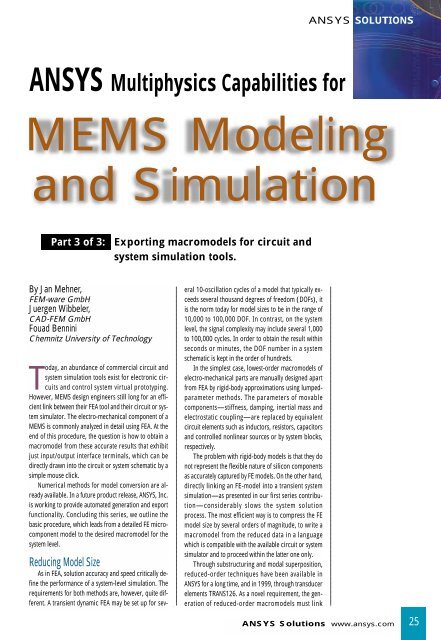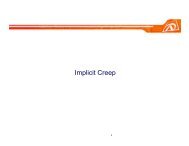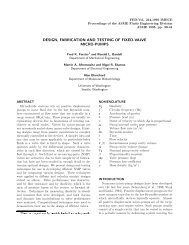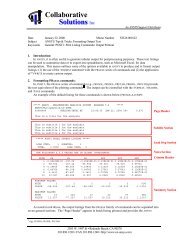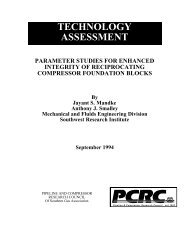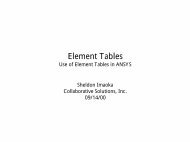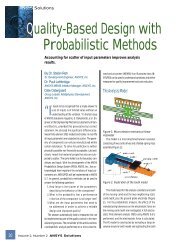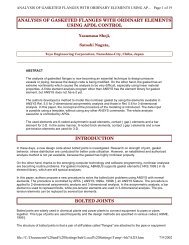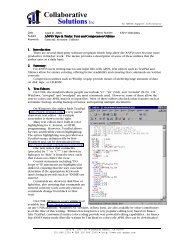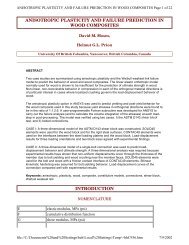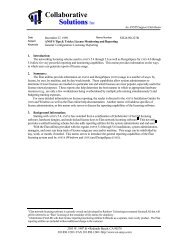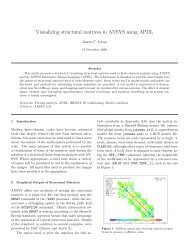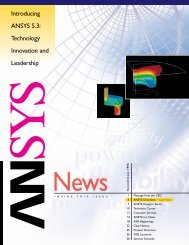MEMS Modeling and Simulation
MEMS Modeling and Simulation
MEMS Modeling and Simulation
Create successful ePaper yourself
Turn your PDF publications into a flip-book with our unique Google optimized e-Paper software.
ANSYS Multiphysics Capabilities for<br />
By Jan Mehner,<br />
FEM-ware GmbH<br />
Juergen Wibbeler,<br />
CAD-FEM GmbH<br />
Fouad Bennini<br />
Chemnitz University of Technology<br />
Today, an abundance of commercial circuit <strong>and</strong><br />
system simulation tools exist for electronic circuits<br />
<strong>and</strong> control system virtual prototyping.<br />
However, <strong>MEMS</strong> design engineers still long for an efficient<br />
link between their FEA tool <strong>and</strong> their circuit or system<br />
simulator. The electro-mechanical component of a<br />
<strong>MEMS</strong> is commonly analyzed in detail using FEA. At the<br />
end of this procedure, the question is how to obtain a<br />
macromodel from these accurate results that exhibit<br />
just input/output interface terminals, which can be<br />
directly drawn into the circuit or system schematic by a<br />
simple mouse click.<br />
Numerical methods for model conversion are already<br />
available. In a future product release, ANSYS, Inc.<br />
is working to provide automated generation <strong>and</strong> export<br />
functionality. Concluding this series, we outline the<br />
basic procedure, which leads from a detailed FE microcomponent<br />
model to the desired macromodel for the<br />
system level.<br />
Reducing Model Size<br />
As in FEA, solution accuracy <strong>and</strong> speed critically define<br />
the performance of a system-level simulation. The<br />
requirements for both methods are, however, quite different.<br />
A transient dynamic FEA may be set up for sev-<br />
eral 10-oscillation cycles of a model that typically exceeds<br />
several thous<strong>and</strong> degrees of freedom (DOFs), it<br />
is the norm today for model sizes to be in the range of<br />
10,000 to 100,000 DOF. In contrast, on the system<br />
level, the signal complexity may include several 1,000<br />
to 100,000 cycles. In order to obtain the result within<br />
seconds or minutes, the DOF number in a system<br />
schematic is kept in the order of hundreds.<br />
In the simplest case, lowest-order macromodels of<br />
electro-mechanical parts are manually designed apart<br />
from FEA by rigid-body approximations using lumpedparameter<br />
methods. The parameters of movable<br />
components—stiffness, damping, inertial mass <strong>and</strong><br />
electrostatic coupling—are replaced by equivalent<br />
circuit elements such as inductors, resistors, capacitors<br />
<strong>and</strong> controlled nonlinear sources or by system blocks,<br />
respectively.<br />
The problem with rigid-body models is that they do<br />
not represent the flexible nature of silicon components<br />
as accurately captured by FE models. On the other h<strong>and</strong>,<br />
directly linking an FE-model into a transient system<br />
simulation—as presented in our first series contribution—considerably<br />
slows the system solution<br />
process. The most efficient way is to compress the FE<br />
model size by several orders of magnitude, to write a<br />
macromodel from the reduced data in a language<br />
which is compatible with the available circuit or system<br />
simulator <strong>and</strong> to proceed within the latter one only.<br />
Through substructuring <strong>and</strong> modal superposition,<br />
reduced-order techniques have been available in<br />
ANSYS for a long time, <strong>and</strong> in 1999, through transducer<br />
elements TRANS126. As a novel requirement, the generation<br />
of reduced-order macromodels must link<br />
ANSYS SOLUTIONS<br />
<strong>MEMS</strong> <strong>Modeling</strong><br />
<strong>and</strong> <strong>Simulation</strong><br />
Part 3 of 3: Exporting macromodels for circuit <strong>and</strong><br />
system simulation tools.<br />
ANSYS Solutions www.ansys.com<br />
25
ANSYS Solutions<br />
System simulation with FEA accuracy. The basic procedure to obtain a macromodel based on FE model<br />
data explained at a scanning micromirror example.<br />
26 Volume 3, Number 4 ANSYS Solutions
together the structural, electrostatic <strong>and</strong> fluidic<br />
domains, not to mention nonlinear characteristics.<br />
Shape Function Methods<br />
The deformation state <strong>and</strong> dynamics of mechanical<br />
systems are accurately described by weighted combination<br />
of mode shape functions or modal superposition.<br />
In fact, shape function methods can also be applied to<br />
nonlinear systems. Geometric nonlinearities, for instance,<br />
stress stiffening, can be regarded if the modal<br />
stiffness is computed from the first derivative of the<br />
strain energy function with respect to the modal amplitudes.<br />
Capacitance-stroke functions provide nonlinear<br />
coupling between each eigenmode <strong>and</strong> the electrical<br />
quantities, such as electrostatic modal forces, electrical<br />
current, if stroke is understood as modal amplitude.<br />
Damping parameters are assigned to each eigenmode,<br />
as described in our second series contribution.<br />
Modal representations of <strong>MEMS</strong> are very efficient<br />
since just one equation per mode <strong>and</strong> one equation per<br />
involved conductor are necessary to describe the coupled<br />
system entirely. The approach will be demonstrated<br />
subsequently as the example of our already<br />
known electrostatic scanning micromirror.<br />
Step 1:<br />
Reduction Procedure<br />
The first step of the ROM generation is to determine<br />
which modes are significant <strong>and</strong> to estimate a proper<br />
amplitude range for each mode. Several criteria can be<br />
applied, for instance the lowest eigenmodes of a modal<br />
analysis, modes in operating direction or modes that<br />
contribute to the deflection state at a typical test load.<br />
Applying a unit voltage as test load at one electrode of<br />
the micromirror reveals that its motion is dominated by<br />
the rotational (1), transversal (3), <strong>and</strong> warp (7) eigenmodes.<br />
Next, the dependencies of the strain energy WSENE<br />
<strong>and</strong> of all mutual capacities Cij from the modal amplitudes<br />
are described by polynomial function fits. The<br />
necessary data points are obtained by imposing each<br />
eigenmode with varying amplitude to the mechanical<br />
model for strain energy <strong>and</strong> to an electrostatic space<br />
model for capacitance. Modal damping parameters are<br />
obtained at a fluidic model (shown at left).<br />
Step 2:<br />
Export Macromodel<br />
In the concept of modal superposition, each eigenmode<br />
represents a single independent resonator with<br />
modal mass mi <strong>and</strong> modal damping ci. The system<br />
schematic replaces the resonator’s equation-of-motion<br />
by a simple arrangement of summation, gain <strong>and</strong> integrator<br />
blocks. Polynomials for nonlinear modal excitation<br />
forces <strong>and</strong> stress-stiffness forces are written into<br />
analytical-function blocks.<br />
The structure of this schematic remains constant<br />
for all types of system simulators, <strong>and</strong> therefore, needs<br />
to be exported into a model file using the appropriate<br />
macro language. In the example, the model was generated<br />
for MATLAB/SIMULINK <strong>and</strong> has three voltage<br />
input ports Vi <strong>and</strong> three mechanical output ports carrying<br />
the elongations of eigenmodes 1, 3 <strong>and</strong> 7. A similar<br />
structure is available for network simulators<br />
where the electrical ports carry bidirectional signals,<br />
according to the Kirchhoffian network theory (VHDL-<br />
AMS language).<br />
Step 3:<br />
System <strong>Simulation</strong><br />
Combined with a feedback controller unit, the<br />
micromirror’s rotation shall realize a smooth saw-toothlike<br />
function for scanning image projection. The system<br />
simulation using MATLAB/SIMULINK traces the mirror<br />
motion in the three implemented modes. In practice, the<br />
transversal mode disturbs the electrostatic forces, which<br />
are meant to drive only the rotational mode. The control<br />
loop must provide compensation for those <strong>and</strong> other<br />
disturbances, which is now the objective of circuit prototyping.<br />
Based on the information about the warp<br />
mode, we are able to conclude on the reflection quality<br />
of the mirror.<br />
A rigid-body-based macromodel would only include<br />
the rotational mode, perhaps, with a strong degree of<br />
approximation, the transversal mode, also. Instead, the<br />
reduction of FE data guarantees an accuracy level typical<br />
for FEA at a system analysis speed typical for system <strong>and</strong><br />
circuit simulators.<br />
While our previous two articles discussed coupledfield<br />
methods that are already available within<br />
ANSYS/Multiphysics, this final article casts a view onto<br />
the near future of <strong>MEMS</strong> virtual prototyping. It requires<br />
far more than one single numerical method. The developments<br />
in most organizations <strong>and</strong> engineering companies<br />
are based on various commercial tools for CAD,<br />
FEA, simulation of electronic circuits, control systems,<br />
multibody systems <strong>and</strong> also the microfabrication<br />
processes. Although we are on the forefront of this<br />
progress, many of these tools will be linked together by<br />
appropriate interfaces.<br />
For further information on reduced order modeling<br />
techniques, read J. Mehner, L. Gabbay <strong>and</strong><br />
S.D.Senturia: Computer-aided Generation of Nonlinear<br />
Reducer-Order Dynamic Macromodels, J. Microelectromech.<br />
Syst., Vol. 9, June 2000, pp. 262-278; <strong>and</strong><br />
F. Bennini, J. Mehner, W. Dötzel: Computational Methods<br />
for Reduced-Order <strong>Modeling</strong> of Coupled Domain<br />
<strong>Simulation</strong>s, 11th Int. Conf. On Solid-State Sensors<br />
<strong>and</strong> Actuators, Germany 2001, pp. 260-263.<br />
ANSYS Solutions www.ansys.com<br />
27


